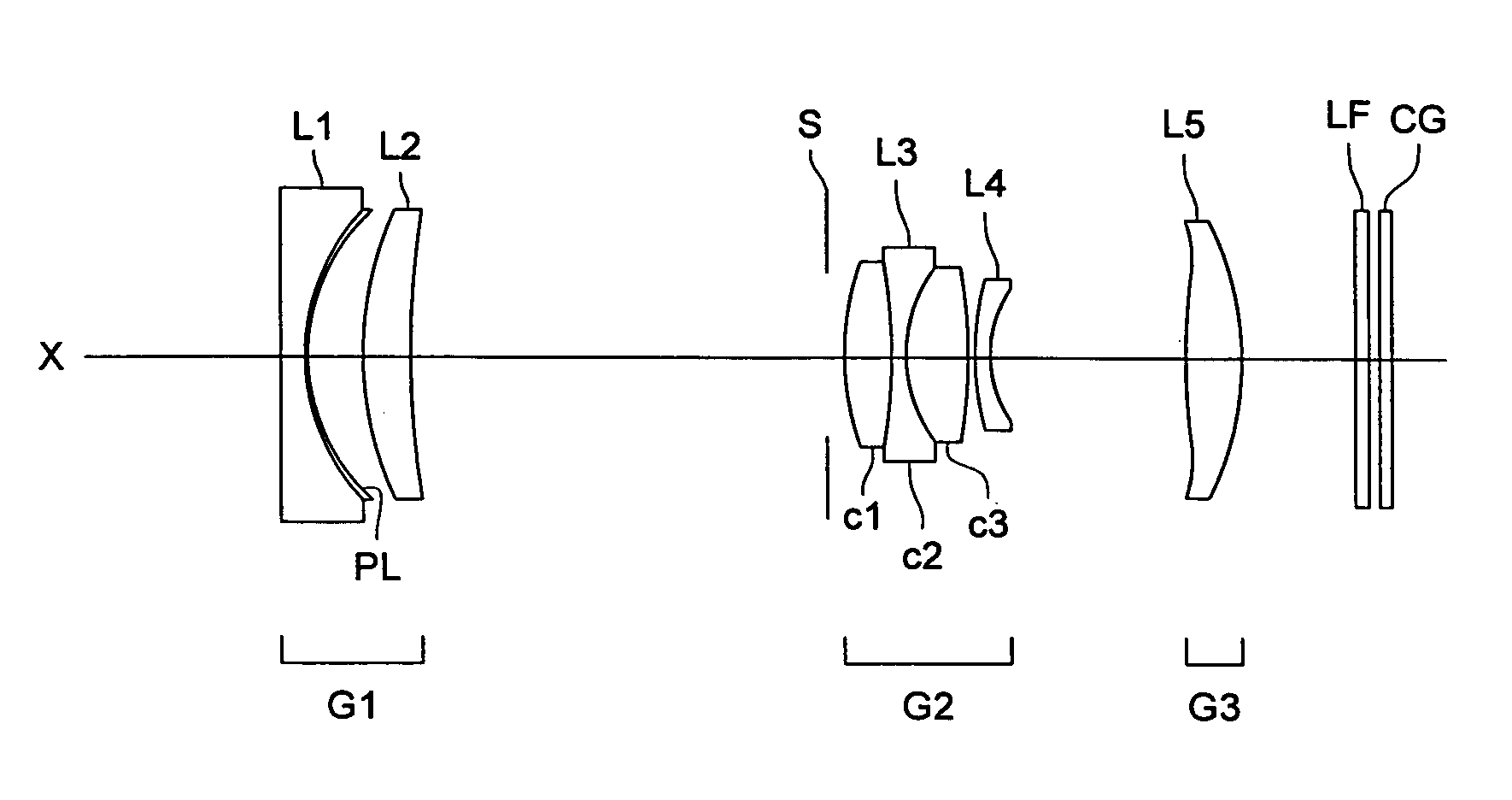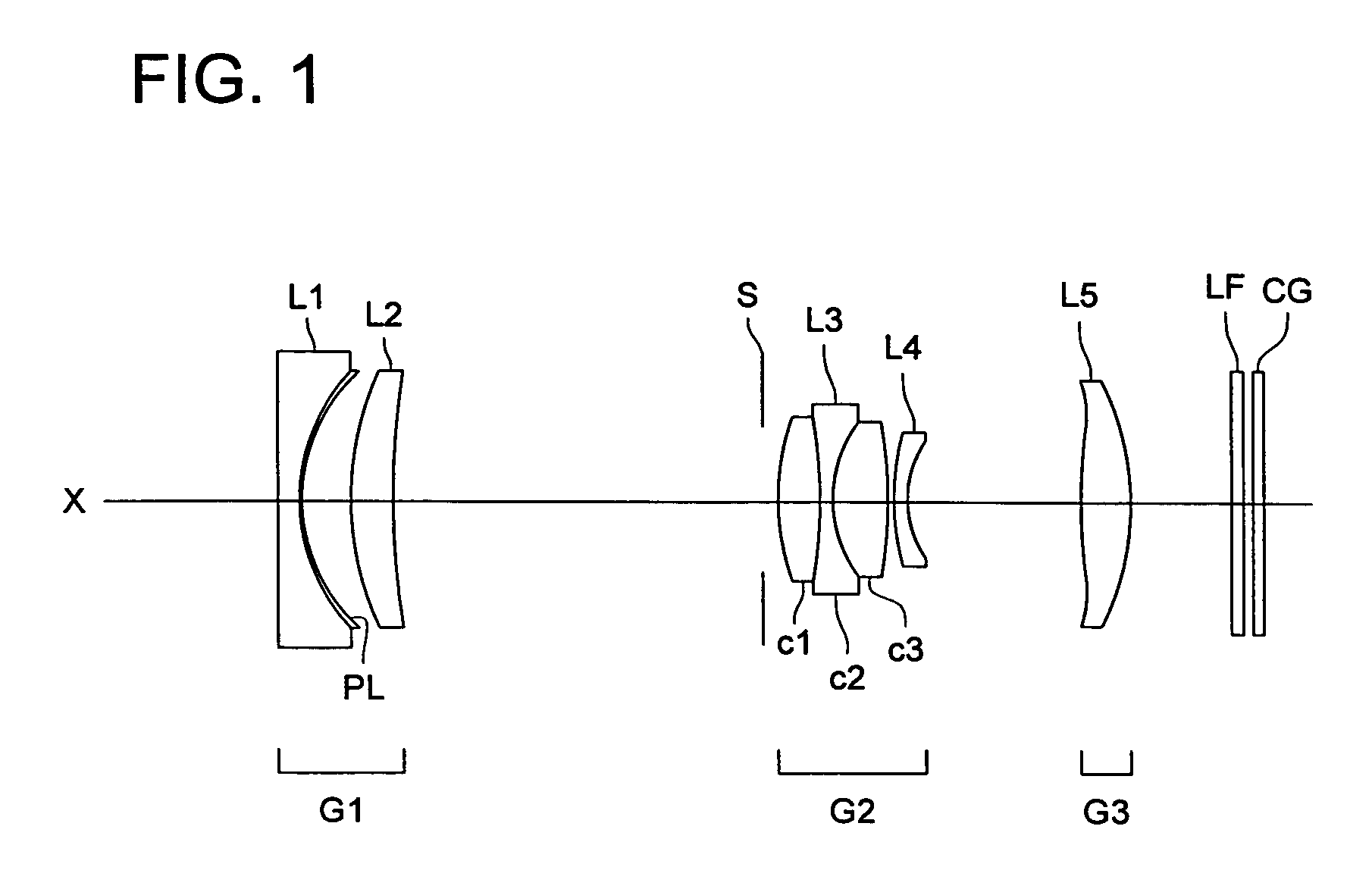Zoom lens
a zoom lens and zoom technology, applied in the field of zoom lens system, can solve the problem that the lateral magnification of the three-element cemented lens system cannot be avoided from becoming bigger, and achieve the effect of wide field angle, optimum corrected aberration, and high power variation ratio
- Summary
- Abstract
- Description
- Claims
- Application Information
AI Technical Summary
Benefits of technology
Problems solved by technology
Method used
Image
Examples
embodiment 1
[0095]Table 1 lists lens data of the zoom lens system in accordance with Embodiment 1. FIG. 1 shows a sectional view of a zoom lens of Embodiment 1 at the wide-angle end. FIG. 2(a-1) to 2(c-3) are explanatory drawings of aberration curves such as spherical aberration, astigmatism, and distortion of a zoom lens of Embodiment 1. FIG. 2(a-1) to 2(a-3) show aberration curves of the zoom lens at the wide-angled end. FIG. 2(b-1) to 2(b-3) show aberration curves at an intermediate position. FIG. 2(c-1) to 2(c-3) show aberration curves of the zoom lens at the telephoto end. In the following aberration diagrams, solid lines represent d-lines and dotted lines represent g-lines. In the astigmatism diagrams, solid lines represent sagittal image surface and dotted lines represent meridional image surfaces.
[0096]
TABLE 1Embodiment 1SurfacenumberR (mm)d (mm)ndνd1153.0790.951.8830040.827.8470.051.5131353.936.6912.02411.8621.891.8466623.8543.804d1 (variable)68.5671.741.7680249.27−32.1460.451.6034238....
embodiment 2
[0099]Table 2 lists lens data of the zoom lens system in accordance with Embodiment 2. FIG. 3 shows a sectional view of a zoom lens of Embodiment 2 at the wide-angle end. FIG. 4(a-1) to 4(c-3) are explanatory drawings of aberration curves such as spherical aberration, astigmatism, and distortion of a zoom lens of Embodiment 2. FIG. 4(a-1) to 4(a-3) show aberration curves of the zoom lens at the wide-angle end. FIG. 4(b-1) to 4(b-3) show aberration curves at an intermediate position. FIG. 4(c-1) to 4(c-3) show aberration curves of the zoom lens at the telephoto end.
[0100]
TABLE 2Embodiment 2SurfacenumberR (mm)d (mm)ndνd187.7220.951.8160046.627.9150.051.5131353.936.9202.33411.6311.731.8466623.8527.306d1 (variable)68.2321.711.7680249.27−47.8560.451.6034238.084.9282.141.7291654.79−58.9670.2010 9.9180.551.7173629.511 4.389d2 (variable)12 30.1061.901.6935053.213 −33.255d3 (variable)14 ∞0.431.5488067.015 ∞0.3916 ∞0.501.5163364.117 ∞Aspheric surface coefficient3rd surfaceK = 0.0A4 = −3.37440...
embodiment 3
[0103]Table 3 lists lens data of the zoom lens system in accordance with Embodiment 3. FIG. 5 shows a sectional view of a zoom lens of Embodiment 3 at the wide-angle end. FIG. 6(a-1) to 6 (c-3) are explanatory drawings of aberration curves such as spherical aberration, astigmatism, and distortion of a zoom lens of Embodiment 3. FIG. 6(a-1) to 6(a-3) show aberration curves of the zoom lens at the wide-angle end. FIG. 6(b-1) to 6(b-3) show aberration curves at an intermediate position. FIG. 6(c-1) to 6(c-3) show aberration curves of the zoom lens at the telephoto end.
[0104]
TABLE 3Embodiment 3SurfacenumberR (mm)d (mm)ndνd152.7940.951.8160046.626.7642.40310.9701.761.8466623.8423.614d1 (variable)57.7021.501.6935053.26−200.0000.551.6034238.075.2752.201.7291654.78−37.0400.2099.2700.601.7173629.510 4.352d2 (variable)11 26.0401.551.6935053.212 −47.694d3 (variable)13 ∞0.401.5488067.014 ∞0.3915 ∞0.501.5163364.116 ∞Aspheric surface coefficient2nd surfaceK = 0.00000E+00A4 = −2.15460E−04A6 = −3.7...
PUM
 Login to View More
Login to View More Abstract
Description
Claims
Application Information
 Login to View More
Login to View More - R&D
- Intellectual Property
- Life Sciences
- Materials
- Tech Scout
- Unparalleled Data Quality
- Higher Quality Content
- 60% Fewer Hallucinations
Browse by: Latest US Patents, China's latest patents, Technical Efficacy Thesaurus, Application Domain, Technology Topic, Popular Technical Reports.
© 2025 PatSnap. All rights reserved.Legal|Privacy policy|Modern Slavery Act Transparency Statement|Sitemap|About US| Contact US: help@patsnap.com



